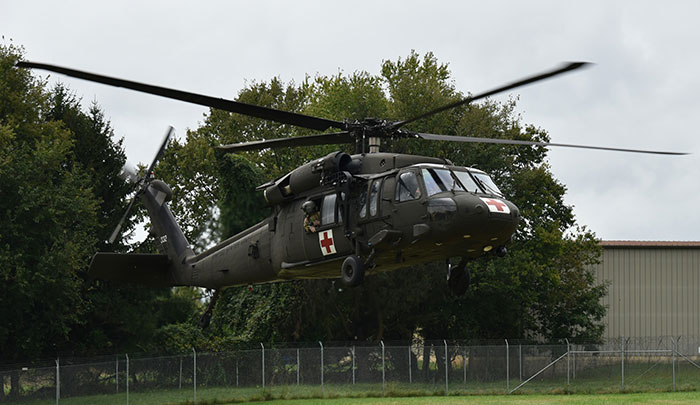AFC, USAMRDC Put Telemedicine Options to the Test

The U.S. Army Medical Research and Development Command hosted a large-scale Army Tactical Telemedicine Performance and Operational Impacts Workshop from September 20-23 at the Air Force Medical Readiness Agency grounds at Fort Detrick, Maryland. The event, facilitated at the request of the Army Futures Command, was designed to showcase several different and cutting-edge telemedicine tools as part of an Analysis of Alternatives exercise to both inform and guide the larger military medical community.
"I think these systems are truly going to benefit us in the long term," said Lt. Col. Nathan Schmidt, current acting director of AFC's The Research and Analysis Center, regarding the event's structure and scope. "Medical information is a key building block in any scenario."
To that end, AFC-TRAC personnel spent the four-day event focusing on three distinct telemedicine alternatives: the Medical Hands-free Unified Broadcast tool; the Joint Medical Exchange and Dissemination of Information for Combat Casualty Care tool and the Battlefield Assisted Trauma Distributed Observation Kit. The stated goal for the more than 40 Soldiers, scientists and researchers in attendance was to determine each tool's key capabilities across a number of different operational scenarios; chiefly noting potential gaps in the Army's ability to monitor and treat combat casualties, to document injuries and treatment and to provide medical situational awareness at echelon to support medical regulating and capacity management. Leaders with AFC-TRAC will use the data collected from the exercise to develop guidance moving forward.
"In many ways this is the ultimate competition," said Jay Wang, a product manager for USAMRDC's U.S. Army Medical Materiel Development Activity, and whose work in the Warfighter Health, Performance, and Evacuation Project Management Office has been the driving force in the development of MEDHUB. "We want to show the [on-site review panel of] 24 medics what makes MEDHUB so special; it's safe to fly, it's effective and it's fully-integrated into current Army computer systems."

Using the effective transfer of patient information as a backdrop – specifically during transport from the point-of-injury to Role 3 care – AFC-TRAC personnel made clear to the respective subject matter experts it was critical to show their product's ability to ensure proper documentation and reduce gaps in information collection during the showcase. AFC-TRAC leaders also emphasized the need for simplicity and accessibility for each specific technology.
Capabilities like MEDHUB – which is an innovative communication platform that utilizes a handheld electronic tablet to share patient information between medics and hospitals during medical evacuations – will be crucial as the U.S. military develops plans for future battlefield scenarios; combat action which – according to the Army's "Force 2025 and Beyond" strategy – will likely take place in such non-traditional settings as small cities and other dense population centers. Given that each setting is fraught with its own mix of challenges, the ability to develop and command medical technology that can aid and supply Soldiers on such multi-domain battlefields will be key to overmatch and eventual success.
Following initial presentations to the assembled group on the opening morning of the event, organizers set aside time for each product's program managers and associated experts to provide technical demonstrations and, also, offer program-level expertise. MEDHUB program mangers used these smaller-group settings to showcase the capabilities of their product in real-time by arranging for a Black Hawk helicopter to use and broadcast the MEDHUB signal during an exhibition flight on September 21.
For those who have been in charge of shepherding these products – in the case of BATDOK over five years, nearly the same for J-MEDIC3, and a similarly long and challenging road for MEDHUB – an opportunity to impact larger Army policy for the better has always been the ultimate goal.
"Things like estimated time of arrival, patient load time – those are logistical problems; that's why you have UPS or Amazon," said Wang, offering a real-world comparison. "As a scientist, I want to take care of the logistical burden so that a doctor can then focus solely on patient care."
AFC-TRAC will gather all data from the four-day workshop and submit to the Capability Development Integration Directorate for the purposes of compiling a Capabilities Development Document. The ensuing CDD is scheduled to be completed in the next three months.














